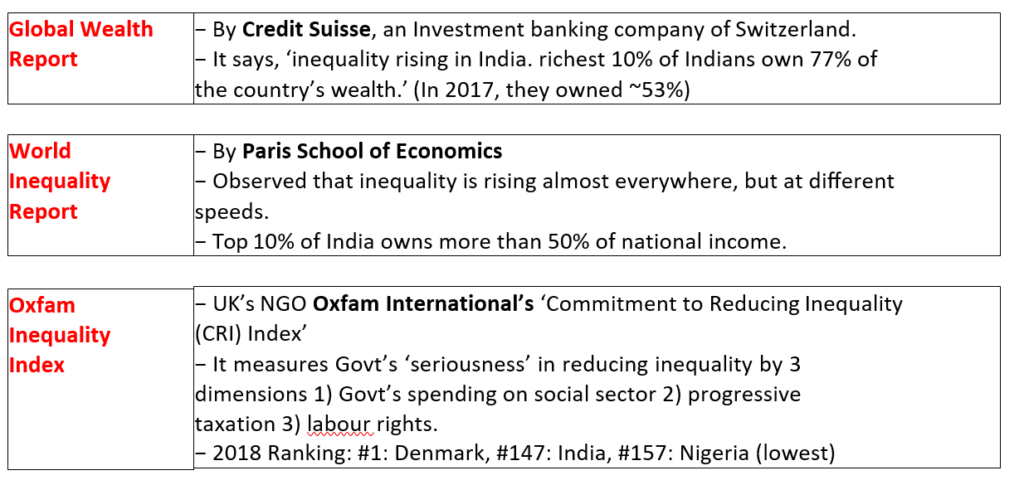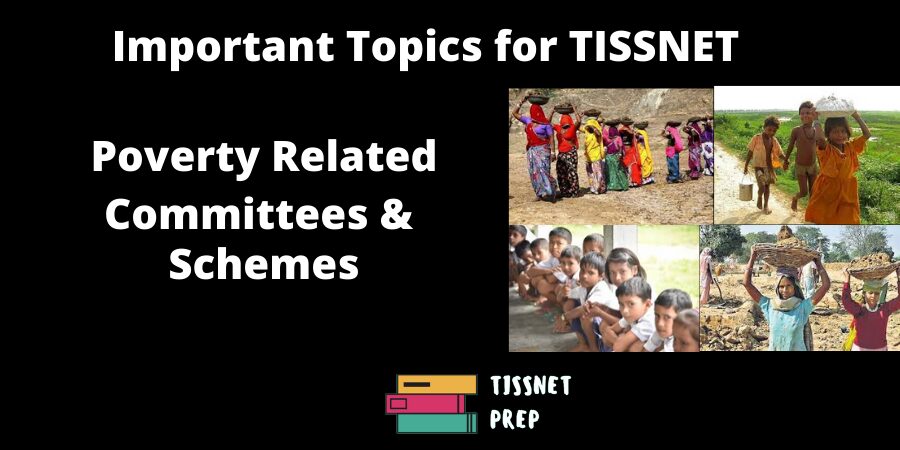Questions related to poverty schemes and committees are often asked in TISSNET GK section. One must not miss to know all much important schemes and committees which can be asked in Gk section of TISSNET
VM Dandekar and N Rath (1971):
It made the first systematic assessment of poverty in India,VM Dandekar and N Rath were of the view that poverty line must be derived from the expenditure that was adequate to provide 2250 calories per day in both rural and urban areas.
Alagh Committee (1979):
Task force constituted by the Planning Commission under the chairmanship of YK Alagh, constructed a poverty line for rural and urban areas on the basis of nutritional requirements and related consumption expenditure.
Lakdawala Committee (1993):
Task Force chaired by DT Lakdawala, based on the assumption that the basket of goods and services used to calculate Consumer Price Index-Industrial Workers (CPI-IW) and Consumer Price Index- Agricultural Labourers (CPI-AL)
Tendulkar Committee (2009)
Expert group constituted by the Planning Commission and, chaired by Suresh Tendulkar, was constituted to review methodology for poverty estimation and to address the following shortcomings of the previous methods.Tendulkar committee computed poverty lines for 2004-05 at a level that was equivalent, in Purchasing Power Parity (PPP) terms to Rs 33 per day.
Rangarajan Committee(2011)
The committee was set up in the backdrop of national outrage over the Planning Commission’s suggested poverty line of ₹22 a day for rural areas.Poverty Threshold: Persons spending below ₹47 a day in cities and ₹32 in villages be considered poor.
Based on this methodology, Rangarajan committee estimated that the number of poor were 19% higher in rural areas and 41% more in urban areas than what was estimated using Tendulkar committee formula.

RURAL DEVELOPMENT PROGRAMMES IN PAST
1. 20 – Point Programme:
The 20-point Economic Programme was announced on 1st July 1975.This programme has three particular aims, these are:
- To ensure Social Justice
- To relieve Unemployment
- To eradicate poverty
2. Minimum Needs Programme (MNP):
The Fifth Plan introduced a Minimum Need Programme (MNP) .
3. Food For Work Programme (FFW)
The Food for Work Programme was launched in April 1977. The programme aims at generation of additional employment opportunities in rural areas and creation of durable community assets, which would strengthen the rural infrastructure. The workers were paid in food grains for the job performed by them.
4. National Rural Employment Programme (NREP)-1980
The ‘Food for
Work’ programme was restructured and renamed as National Rural Employment
Programme (NREP) in October 1980. This is being implemented as centrally
sponsored programme with 50 per cent sharing basis between the Centre and States. Additional employment of the order of 300-400 million man-days per year for the unemployed and underemployed was envisaged under the NREP.
5. Rural Landless Employment Guarantee Programme (RLEGP).1989
- Jawahar Rozgar Yojana (JRY)1989
:Jawahar Rozgar Yojana (JRY) was launched in 28th April 1989. All the ongoing rural wage employment programmes like NREP and RLEGP merged into the JRY.
7. Indira Awas Yojana (IAY):1985—PMAY(Restructured)
Indira Awas Yojana (IAY) was launched in May 1985. This programme aimed at providing fireproof shelter at free of cost to the rural poor living below the poverty line. The preferred beneficiaries are, Scheduled Castes, Scheduled Tribes and freed bonded labourers.
8. MGNREGA (2005):
- 2005: Parliament enacted MGNREGA Act.
- 2006: launched in 200 districts → 2008: launched in the whole country
9. Deen Dayal Antyodaya Yojana(2016):
National Urban Livelihoods Mission & National Rural Livelihoods Mission will deal with imparting skills and training to rural and urban poors And promotion of SHGs
10. Mission Antyodaya (2017)
Target- At least 50,000 Gram Panchayats become poverty free by 2020. Government will implement the ongoing schemes with more vigilance and
accountability with the help of Gram Panchayat, NGOs, SHGs, ASHA workers etc.
11. Sarva Shiksha Abhiyan(SSA) 2OOO
It is an attempt to provide an opportunity to all children between 6 and 14 years of age to get free education which is also a basic fundamental right. The state and the central government share the expenses of this project.
12. Sansad Adarsh Gram Yojana(2014)
launched in 2014 by the Government of India in which each Member of Parliament will take the responsibility of three villages and look after the personal, human, social, environmental and economic development of the villages. This would substantially improve the standard of living as well as the quality of life in the villages.
13. Antyoday Anna Yojana(2000)
the Antyodaya Anna Yojana aimed at providing food grains to around 2 crore people at subsidised rates. As per the scheme Below Poverty Line (BPL) families were provided 35 kgs of food grains. Rice was provided at the rate of Rs 3/kg and wheat at the rate of Rs 2/kg. The scheme was first launched in Rajasthan but has now been implemented in all Indian states.
14. Deen Dayal Upadhyaya Grameen Kaushalya Yojana(2014)
as part of National Livelihood Mission, has the objectives of catering to the career aspirations of the rural youth and adding diversity to the income of rural families. Launched on 25th September 2014, the scheme’s prime focus is on the rural youth of poor families aged between 15 and 35. An amount of Rs 1500 crores has been provided for the scheme which will help in enhancing employability.
World Inequality Report


